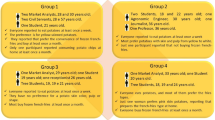Abstract
A chemical ecological model can be the basis for defining testable hypotheses concerning human interactions with plants. Selection by Aymara subsistence cultivators against toxic glycoalkaloids in the ongoing domestication of the Bolivian potato cultigen Solanum X ajanhuiriwas used as a specific case study of human interactions with phytochemicals. In taste perception tests, Aymara subjects were able to discriminate between concentrations of pure glycoalkaloids in solution only above 20 mg/100 ml. Taste panel tests of potato clones indicated that glycoalkaloid levels are important to the Aymara in determining quality only as part of a decision-making process involving two character states: too high or acceptable. Glycoalkaloids in potatoes are regarded as toxic to humans above 20 mg/100 g fresh weight. Among the Aymara, a breakpoint in the curve for glycoalkaloid preference appears to occur between 20–38 mg/100 g. This distinction is evident in the Aymara potato taxonomy which distinguishes bitter (luq'i ch'oke) from nonbitter (ch'oke) potatoes.
Similar content being viewed by others
References
Brush, S. (1980). Potato taxonomies in Andean agriculture. In Brokencha, D. W., Warren, D. M., and Werner, O. (eds.),Indigenous Knowledge Systems and Development. University Press of America, Lanham, pp. 37–47.
Brush, S. B., Carney, H. J., and Huamán, Z. (1981). Dynamics of Andean potato agriculture.Economic Botany 35: 70–88.
De Lucca, M. (1983).Diccionario Aymara-Castellano Castellano-Aymara. Comision de Alfabetizacion y Literatura en Aymara, La Paz.
Gregory, P., Sinden, S. L., Osman, S. F., Tingey, W. M., and Chessin, D. A. (1981). Glycoalkaloids of wild, tuber-bearingSolanum species.Journal of Agricultural and Food Chemistry 29: 1212–1215.
Hawkes, J. G. (1947). On the origin and meaning of South American Indian potato names.Journal of Linnean Society, Botany 53: 205–250.
Huamán, Z. (1975).The Origin and Nature of Solanum ajanhuiri Juz et Buk., a South American Cultivated Diploid Potato. Ph.D. dissertation, University of Birmingham, U.K.
Jackson, M. T., Hawkes, J. G., and Rowe, P. R. (1980). An ethnobotanical field study of primitive potato varieties in Peru.Euphytica 29: 107–113.
Jadhav, S. J., Sharma, R. P., and Salunkhe, D. K. (1981). Naturally occurring toxic alkaloids in foods.CRC Critical Reviews in Toxicology 9: 21–104.
Johns, T. A. (1985).Chemical Ecology of the Aymara of Western Bolivia: Selection for Glycoalkaloids in the Solanum X ajanhuiri Domestication Complex. Ph.D. dissertation, University of Michigan, Ann Arbor.
Johns, T. (1986a). Chemical selection in Andean domesticated tubers as a model for the acquisition of empirical plant knowledge. In Etkin, N. L. (ed.),Plants Used in Indigenous Medicine and Diet: Biobehavioral Approaches. Redgrave Publishers, South Salem, New York, pp. 266–288.
Johns, T. (1986b). The detoxification function of geophagy and the domestication of the potato.Journal of Chemical Ecology 12: 635–646.
Johns, T., and Keen, S. L. (1985). Determinants of taste perception and classification among the Aymara of Bolivia.Ecology of Food and Nutrition 16: 253–271.
Johns, T., and Keen, S. L. (1986). Ongoing evolution of the potato in the altiplano of western Bolivia.Economic Botany 40: 409–424.
Johns, T., and Osman, S. F. (1986). Glycoalkaloids ofSolanum SeriesMegistacrolobum and related potato cultigens.Biochemical Systematics and Ecology 14: 651–655.
Johns, T., Huamán, Z., Ochoa, C. M., and Schmiediche, P. E. (1987). Relationships among wild, weed and cultivated potatoes in theSolanum Xajanhuiri complex.Systematic Botany. In press.
La Barre, W. (1947). Potato taxonomy among the Aymara Indians of Bolivia.Acta Americana 5: 83–103.
Larmond, E. (1977).Laboratory Methods for Sensory Evaluation of Food. Canada Department of Agriculture Publication 1637, Ottawa.
Neter, J., and Wasserman, W. (1974).Applied Linear Statistical Models. R. D. Irwin, Illinois.
Nishie, K., Norred, W. P., and Swain, A. P. (1975). Pharmacology and toxicology of chaconine and tomatine.Research Communications in Chemical Pathology and Pharmacology 12: 657–667.
Nishie, K., Fitzpatrick, T. J., Swain, A. P., and Keyl, A. C. (1976). Positive inotropic action of Solanaceae glycoalkaloids.Research Communications in Chemical Pathology and Pharmacology 15: 601–607.
Osman, S. F., Herb, S. F., Fitzpatrick, T. J., and Schmiediche, P. (1978). Glycoalkaloid composition of wild and cultivated tuber-bearingSolanum species of potential value in potato breeding programs.Journal of Agricultural and Food Chemistry 26: 1246–1248.
Osman, S. F., Johns, T. A., and Price, K. R. (1986). Sisunine, a glycoalkaloid found in hybrids betweenSolanum acaule andSolanum Xajanhuiri.Phytochemistry 25: 967–968.
Rindos, D. (1980). Symbiosis, instability and the origins and spread of agriculture: A new model.Current Anthropology 21: 751–772.
Rosenthal, G. A., and Janzen, D. H. (1979).Herbivores: Their Interaction with Secondary Plant Metabolites. Academic Press, New York.
Rozin, P. (1976). The selection of food by rats, humans and other animals.Advances in the Study of Behavior 6: 21–76.
Schrieber, K. (1968). Steroidal alkaloids: TheSolanum group.Alkaloids 10: 1–192.
Sinden, S. L., Deahl, K. L., and Aulenbach, B. B. (1976). Effects of glycoalkaloids and phenolics on potato flavor.Journal of Food Science 41: 520–523.
Solms, J., and Wyler, R. (1979). Taste components of potatoes. In Boudreau, J. (ed.), ACS Symposium Series No. 115.
Werge, R. W. (1979). Potato processing in the central highlands of Peru.Ecology of Food and Nutrition 1: 229–234.
Wrangham, R. W., and Nishida, T. (1983).Aspilia spp. leaves: A puzzle in the feeding behavior of wild chimpanzees.Primates 24: 276–282.
Author information
Authors and Affiliations
Rights and permissions
About this article
Cite this article
Johns, T., Keen, S.L. Taste evaluation of potato glycoalkaloids by the Aymara: A case study in human chemical ecology. Hum Ecol 14, 437–452 (1986). https://doi.org/10.1007/BF00888308
Issue Date:
DOI: https://doi.org/10.1007/BF00888308




